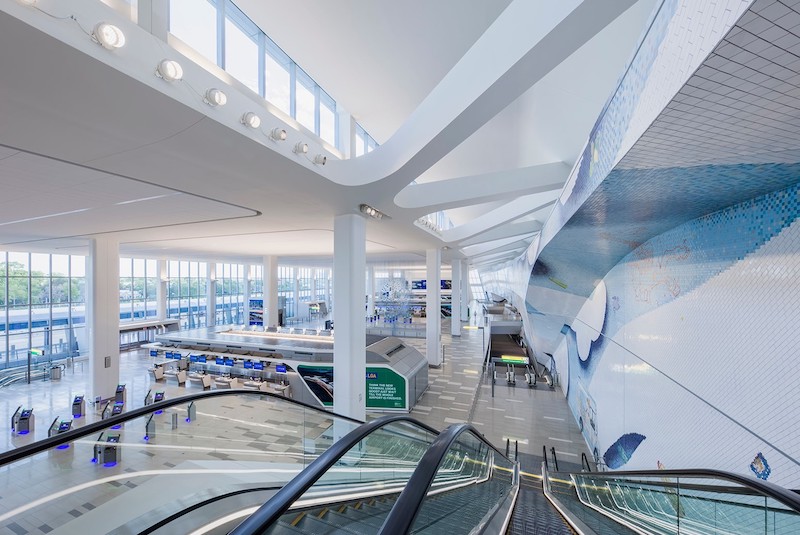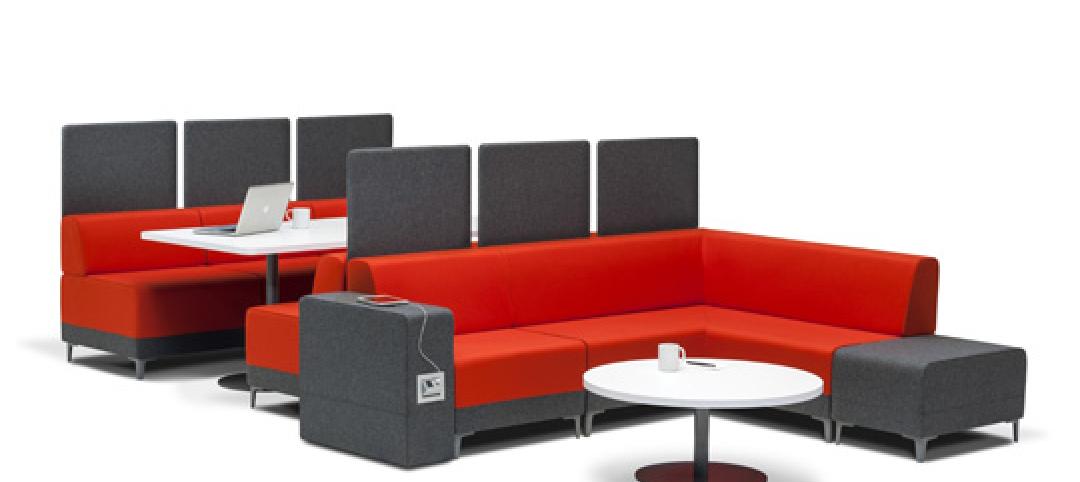LaGuardia Airport’s new Terminal B, a four-story, 850,000-sf facility that houses passenger services and amenities, has officially opened.
The steel-framed facility replaces a disjointed patchwork of structures with one that closely follows the curves of the Grand Central Parkway and the airport access roads. It was designed as a highly efficient and adaptable terminal that pays homage to the “architectural grandeur and individuality” of New York City.
“Our design concept focuses on two main components: a superior passenger experience and an exterior architectural expression that conveys a civic presence from the Grand Central Parkway,” said Carl Galioto, FAIA, HOK’s President and New York Office Managing Principal. “The building is a metaphor for New York, a city of islands and bridges, and the terminal is connected to the city with views of the skyline from the passenger bridges. Our ambition was to help transform LaGuardia into an airport with a distinct civic identity worthy of this metropolis.”
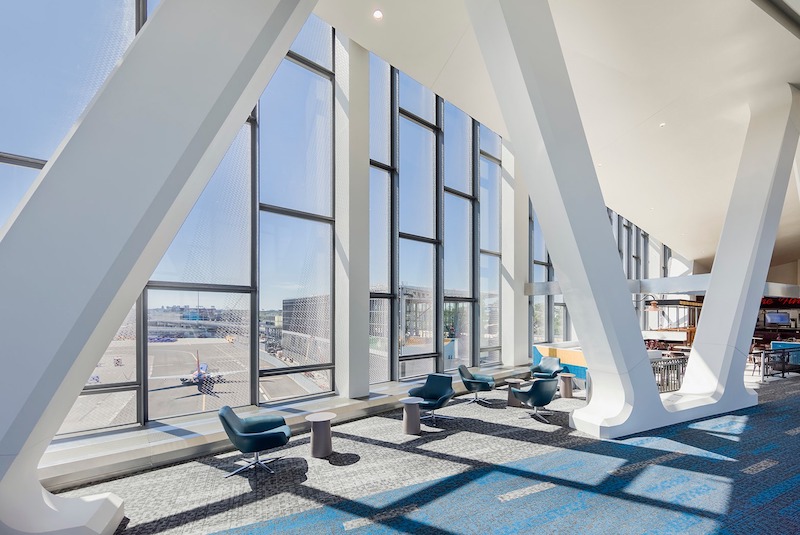
Also known as a headhouse, Terminal B includes extensive food and beverage and retail options. Connected to two island concourses by a pair of 450-foot-long steel truss pedestrian bridges, the headhouse serves as the nexus to the new Terminal B. Arriving and departing passengers can view panoramic skyline and airfield views from the transparent-walled, 65-foot-high bridges as taxiing planes pass underneath them. The bridges also enabled the design team to move the terminal 600 feet closer to the Grand Central Parkway, which allowed for two additional miles of aircraft taxi lanes that will reduce airport ground delays.
The team designed a simplified circulation network comprising over eight miles of new roadway and 20 new bridges that provide an easy connection from the airport to the Grand Central Parkway and New York City. The roadways in front of the head house frame the Grand Central Parkway, and its column structures align with the head house design to create a cohesive appearance.
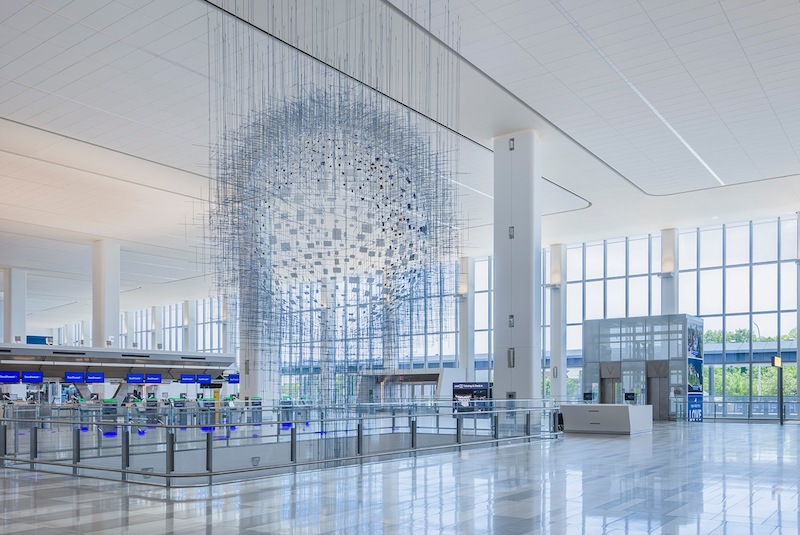
Inside the terminal, all check-in and passenger screening areas are located on the third floor. This location gives Terminal B the adaptability to accommodate evolving security screening and technology as needs change. The “common-use” design allows airlines to move easily within the terminal, expanding or shrinking their footprints as needed.
See Also: A 780-ft-long pedestrian walkway is positioned over an active taxi lane at Sea-Tac International
Terminal B forgoes the widespread practice among airports of offering monumental spaces to departures while relegating low-ceilinged, basement-like zones to arrivals; incoming and outgoing passengers to Terminal B share soaring, grand-scaled sequences.

Sustainability features include non-glare daylighting, passive shading, natural local materials, and storm resiliency and the new infrastructure layout will reduce the airport’s overall carbon footprint due to lower fuel demands from taxiing aircraft. The project is targeting LEED Silver certification.
LaGuardia Gateway Partners is composed of Vantage Airport Group, Skanska, Meridiam and JLC Infrastructure for development and equity investment. Vantage Airport Group leads the redevelopment program and management of Terminal B, with Skanska Walsh as the design-build joint venture and HOK and WSP for design.
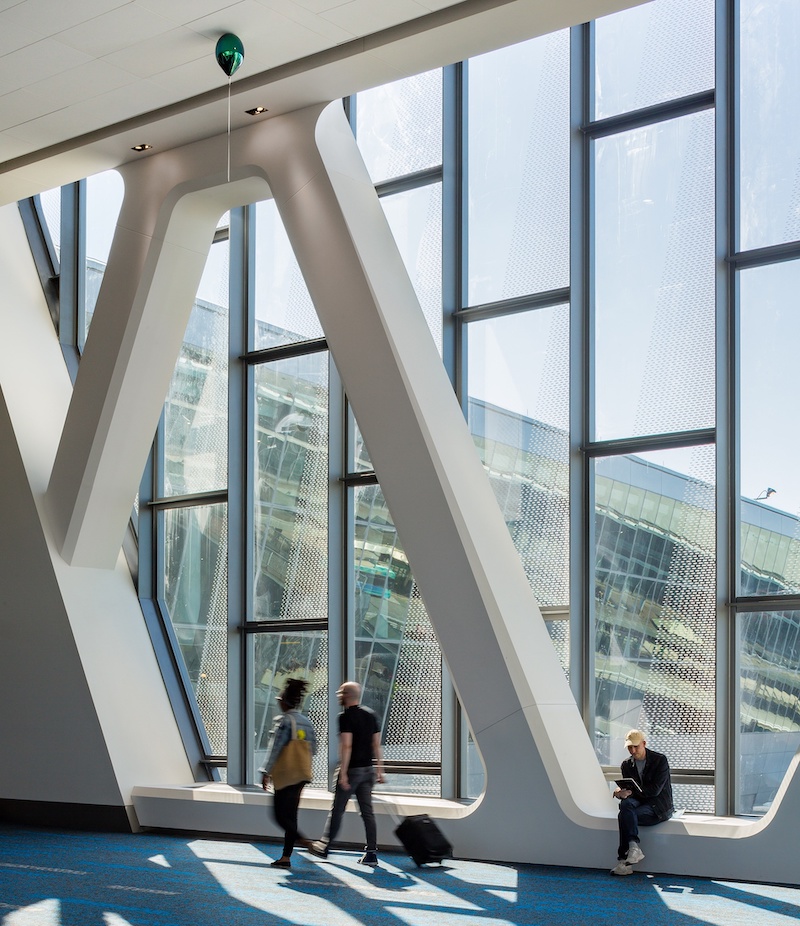
Related Stories
| Jul 2, 2014
Emerging trends in commercial flooring
Rectangular tiles, digital graphic applications, the resurgence of terrazzo, and product transparency headline today’s commercial flooring trends.
| Jun 30, 2014
Arup's vision of the future of rail: driverless trains, maintenance drones, and automatic freight delivery
In its Future of Rail 2050 report, Arup reveals a vision of the future of rail travel in light of trends such as urban population growth, climate change, and emerging technologies.
| Jun 18, 2014
Arup uses 3D printing to fabricate one-of-a-kind structural steel components
The firm's research shows that 3D printing has the potential to reduce costs, cut waste, and slash the carbon footprint of the construction sector.
| Jun 12, 2014
Austrian university develops 'inflatable' concrete dome method
Constructing a concrete dome is a costly process, but this may change soon. A team from the Vienna University of Technology has developed a method that allows concrete domes to form with the use of air and steel cables instead of expensive, timber supporting structures.
| Jun 2, 2014
Parking structures group launches LEED-type program for parking garages
The Green Parking Council, an affiliate of the International Parking Institute, has launched the Green Garage Certification program, the parking industry equivalent of LEED certification.
| May 29, 2014
7 cost-effective ways to make U.S. infrastructure more resilient
Moving critical elements to higher ground and designing for longer lifespans are just some of the ways cities and governments can make infrastructure more resilient to natural disasters and climate change, writes Richard Cavallaro, President of Skanska USA Civil.
| May 23, 2014
Top interior design trends: Gensler, HOK, FXFOWLE, Mancini Duffy weigh in
Tech-friendly furniture, “live walls,” sit-stand desks, and circadian lighting are among the emerging trends identified by leading interior designers.
| May 20, 2014
Kinetic Architecture: New book explores innovations in active façades
The book, co-authored by Arup's Russell Fortmeyer, illustrates the various ways architects, consultants, and engineers approach energy and comfort by manipulating air, water, and light through the layers of passive and active building envelope systems.
| May 19, 2014
What can architects learn from nature’s 3.8 billion years of experience?
In a new report, HOK and Biomimicry 3.8 partnered to study how lessons from the temperate broadleaf forest biome, which houses many of the world’s largest population centers, can inform the design of the built environment.
| May 13, 2014
19 industry groups team to promote resilient planning and building materials
The industry associations, with more than 700,000 members generating almost $1 trillion in GDP, have issued a joint statement on resilience, pushing design and building solutions for disaster mitigation.


